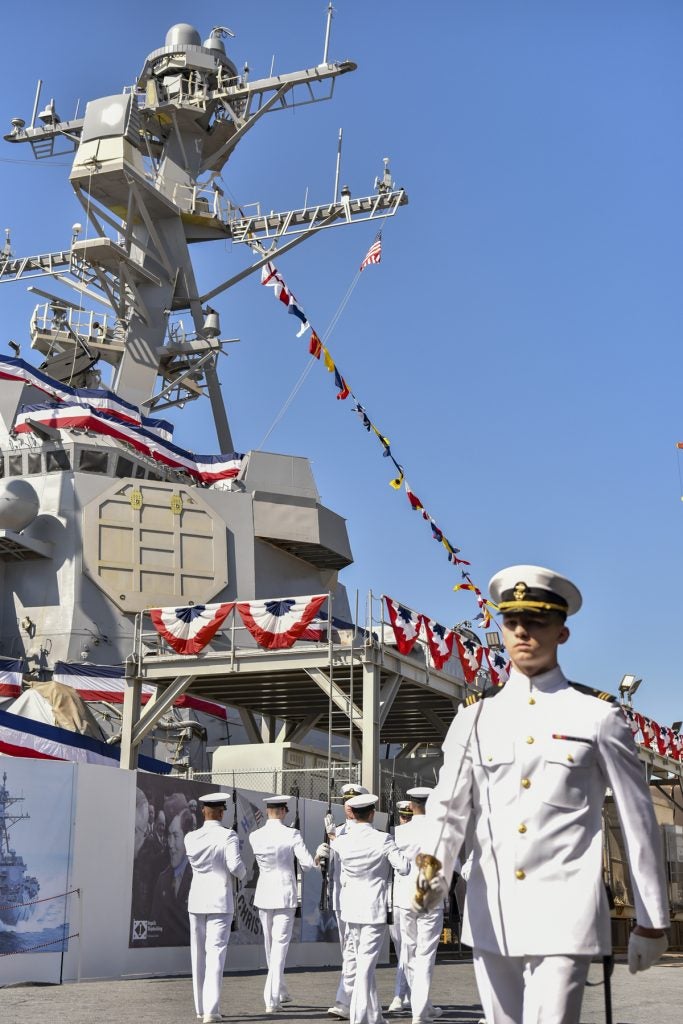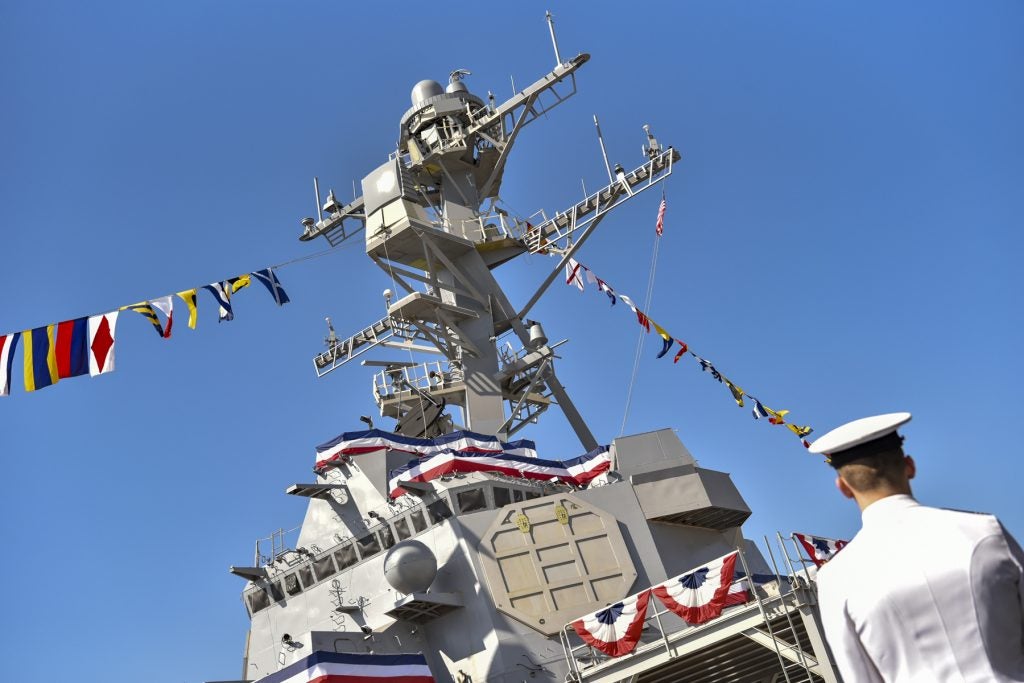U.S. Navy Christens Its Most Advanced Arleigh Burke Variant
The U.S. Navy christened its first Flight III Arleigh Burke-class guided-missile destroyer on March 26, the future USS Jack H. Lucas (DDG 125) was pier side in Pascagoula, Mississippi where the ceremony was held.
USS Jack H. Lucas built by Ingalls Shipbuilding had its keel-laying ceremony on the 7th of November, 2019. The vessel is the first ship of the Flight III configuration and was ordered by the U.S. Navy in 2013. Flight III Arleigh Burkes replace the AN/SPY-1 with the new AN/SPY-6(V)1 Air and Missile Defense Radar (AMDR) built by Raytheon.
The U.S. Navy has procured 12 Flight III ships, including ten ships bought as a part of its previous Multi-Year Procurement which lasted from FY2018 to FY2022. Lawmakers have called for the U.S. Navy to enter into another MYP lasting from 2023 to 2027 in order to support the industrial base while smoothing out the transition into the future DDG(X), this move was further supported by language in the Fiscal Year 2022 appropriations bill.
The House Armed Services Committee’s H.R. 4350 (H.Rept. 117-118) reads:
“The committee remains concerned that the Navy is not adequately planning for the DDG(X) procurement. The current DDG–51 multiyear procurement contract ends in fiscal year 2022, and the Navy has yet to produce program milestones or an acquisition strategy for the next large surface combatant, known as DDG(X)… Therefore, in order to mitigate this risk and ensure a smooth shipbuilding manufacturing and design industrial base transition from DDG–51 to DDG(X), elsewhere in this Act, the committee authorizes a multi-year procurement for up to 15 Flight III DDGs beginning in fiscal year 2023.”
In the latest Fiscal Year 2023 budget request the Navy asks for two Flight III ships a year through till FY27. If this is funded, it would bring the total Flight III buy to 22 ships by FY27, after which procurement of the DDG(X) will begin.
The Arleigh Burke Flight III Configuration

The main upgrade that Flight IIIs bring centers around the SPY-6 radar, which is an Active Electronically Scanned Array (AESA) radar capable of conducting air and missile defense simultaneously, this new radar also improves the detection range of the ship, allowing it to detect smaller targets at almost double the range of the radar it’s replacing. In order to fully utilize the capabilities of this radar, the ships also get the latest baseline of the Aegis Weapon System (AWS) and associated hardware to run it. The new software baseline is what will make the radar more capable than its predecessor, combining its AESA architecture with a very advanced software backend capable of better resource allocation.
Radar resource allocation is the process by which the Combat System of a ship instructs the ship’s radar to allocate sections of the radar’s emitted energy for certain tasks. This can range from dedicating all the radar’s resources to tracking a single very faint target or else dividing up the resources for tracking enemy aircraft and any missiles or munitions they launch. Radar resource allocation has been a challenge for the U.S. Navy on its Flight I and II Arleigh Burkes. Due to software limitations, they can not conduct simultaneous air and ballistic missile defense.
In order to mitigate this problem, the U.S. Navy has outlined software upgrades for these vessels, the upgrade involves modernizing the vessels to the AEGIS Baseline 9, which will give Flight I and II ships the ability to conduct Integrated Air and Missile Defense (IAMD). However, the number of vessels getting this upgrade has been reduced ever since the plans were first announced.
Reaching the Limits
The incorporation of a more powerful radar and combat system to the Arleigh Burke hull has necessitated some major changes. According to a 2016 report from the Government Accountability Office, the Navy had to make modifications not only to the vessel’s power generation and cooling capabilities but also to the internal arrangement of machinery and outside hull structure.
“The ship’s deckhouse must be modified because the SPY-6 radar is considerably deeper and heavier than the legacy DDG 51 radar. In particular, the positioning of the SPY-6 radar arrays high on the deckhouse has a significant impact on the ship’s estimated weight and center of gravity. As part of the preliminary design, the Navy introduced plans to widen the ship’s stern by up to 4 feet on each side, allowing the ship to carry more weight to accommodate SPY-6 and restore available weight service life allowance” states the GAO’s 2016 report. “Significant upgrades to the ship’s electric plant and air conditioning systems also are required to support SPY-6 radar operations. These upgrades involve the use of generators, power conversion modules, transformers, power distribution equipment, and high-efficiency air conditioning units that are new to the DDG 51 class of ships.”
These significant changes have maxed out the size, weight, power, and cooling capabilities of the Arleigh Burke hull form, leading to the current Flight IIIs having less power margin than Flight I, II, and IIA ships. As the U.S. Navy continues to retire its Ticonderoga-class cruisers, the new Flight III ships will be increasingly important assets as they take on more roles traditionally assigned to the Ticos, including hosting the Carrier Strike Group’s Air Defense Commander.

